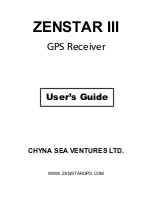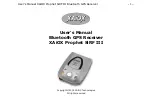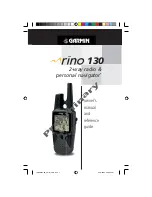
your position is our focus
•
Distance travelled:
Odometer
pulses
•
Direction:
Forward
/
backward
indicator
•
Angular turn rate:
Gyroscope
1.3 Dead Reckoning Performance
As
DR
is
an
incremental
algorithm,
the
quality
of
the
DR
position
depends
very
much
on
the
quality
and
stability
of
the
sensors
used.
An
accurate
model,
low
tolerances
and
low
thermal
drifts
are
essential
for
reliable
position
output.
The
performance
figures
of
a
DR
system
are
always
proportional
to
distance
traveled
or
time.
y
n
x
n
calculated route
based on sensor
signals
Known parameters:
S
=
Traveled
distance
since GPS
Signals
lost
d
=
Distance
error
Performance parameters:
d/S
=
Position
error
percentage
in
comparison
to
distance
traveled
∆Φ
=
Angular
heading
error
Fix types:
= GPS
position
=
DR
position
=
Real
position
d
∆Φ
Actual route
Length = S
x
y
Figure 3: Dead Reckoning Performance Parameters
The
seamless
transition
between
absolute
GPS
positions
and
relative
DR
positions
is
advantageous
in
getting
optimal
performance
from
a
DR
enabled
GPS
receiver.
ANTARIS
®
4
GPS
Technology
employs
blended
algorithms
to
obtain
the
optimum
from
both
systems.
GPS
Positioning
is
weighted
more
heavily
as
long
as
the
GPS
parameter
(e.g.
DOP,
number
of
satellites,
signal
quality)
indicates
good
and
reliable
performance.
In
situations,
where
the
GPS
signals
are
poor,
reflected
from
buildings
(multipath)
or
jammed
the
DR
solution
is
used
with
a
higher
weighting.
Poor GPS
No GPS
Good GPS
GPS
DR
GPS
DR
GPS
DR
Extrapolation
Blending
Calibration
EKF
EKF
EKF
Position,
Velocity,
Time
Position,
Velocity,
Time
Position,
Velocity,
Time
from
real-time
clock
Altitude
held
constant
Figure 4: Dead Reckoning Blending
LEA-4R
/
TIM-4R
-
System
Integration
Manual
/
Reference
Design
Dead
Reckoning
Fundamentals
GPS.G4-MS4-05043
Page 8






































